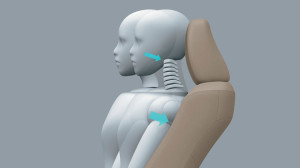3 Things You Need to Know About Whiplash Syndrome
Whiplash syndrome, a condition commonly associated with automobile accidents, is a hyperextension injury of the cervical spine. Roughly 1 million whiplash injuries are experienced each year, and the incidence of insurance claims for whiplash is around 1 per 1000 population per year.
While there is controversy surrounding the pathophysiology, evaluation and treatment strategies for whiplash syndrome, the condition presents real facts that can help you better understand this painful syndrome. Here are three things you need to know about whiplash syndrome:
1. Whiplash is diagnosed on a five-grade scale, from 0 to IV.
Whiplash disorders are classified according to the severity of symptoms and presence of musculoskeletal and neurologic signs. The clinicalanatomic axis of whiplash classification has five grades with grade 0 patients being asymptomatic. These grades increase by severity of symptoms up to grade IV, in which patients experience spinal cord injury or fracture/dislocation of the bony elements of the spine.
2. Hyperextension of the neck is thought to be the primary mechanism of injury for majority of whiplash-associated disorders.
When a patient experiences whiplash, the acceleration–deceleration forces are thought to produce an extension of the lower cervical vertebrae without translational movement. This type of movement can lead to a spectrum of musculoligamentous and disk injuries, separation of the anterior end of the vertebral bodies, and compression of the zygapophysial joints posteriorly. The results can be painful, leading to a disruption of the anterior longitudinal ligament (leading to hemorrhage beneath the prevertebral fascia), stretching of the posterior longitudinal ligament, fracture of zygapophysial joint, and tears of annulus fibrosus.
3. Immobilization is not necessarily the best path to recovery.
While earlier treatments involved immobilizing the neck with a brace and bed rest, numerous studies have shown that the return to normal daily activities and early mobilization are the most beneficial paths to recovery. Of course, the grade of disorder (0 – IV) a patient experiences factors heavily into the type of treatment he or she will be prescribed. Treatments with a high degree of success include manipulative and physical therapy, which provide pain relief and keep the neck from becoming stiff. Surgery may also be used to treat higher grade disorders as well. Percutaneous radiofrequency neurotomy for cervical zygapophysial joint pain has been shown to provide symptomatic relief by targeting medial branches of cervical dorsal rami. The regeneration of these nerves causes recurrence of symptoms in about a year.
Have you experienced whiplash, resulting from a car accident? Get in touch with Dr. Sharma for a proper diagnosis and a course of treatment that can restore your neck and spine health.
Image courtesy of Toyota

Categories
Archives
Contact Dr. Mudit Sharma
Phone: (571) 921-4877
Toll Free: (855) 774-6334
Monday – Thursday: 8am – 4pm
Friday: 8am – 2pm
Fredericksburg
4604 Spotsylvania Parkway, Suite 300 Fredericksburg, VA 22408
Manassas
8650 Sudley Road, Suite 315
Manassas, VA 20110-4418

